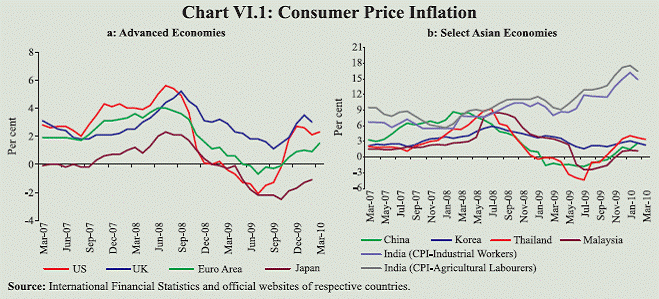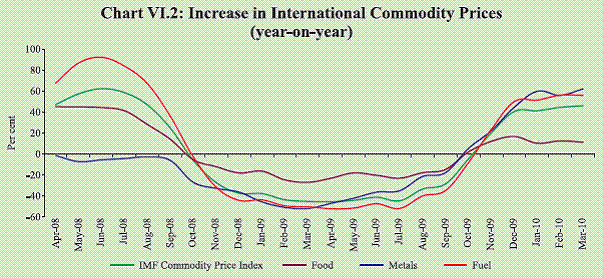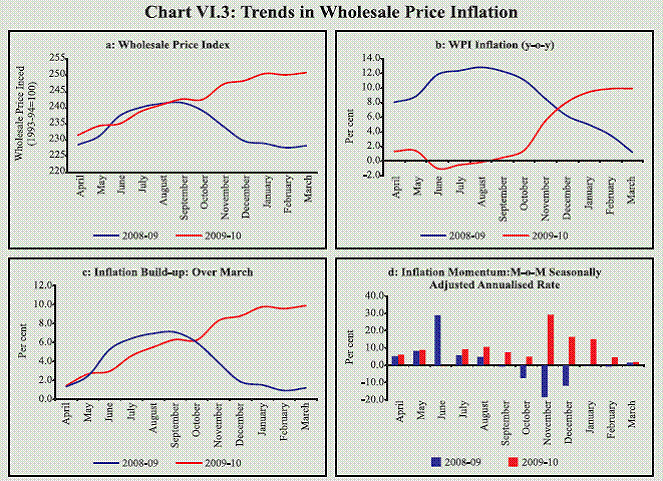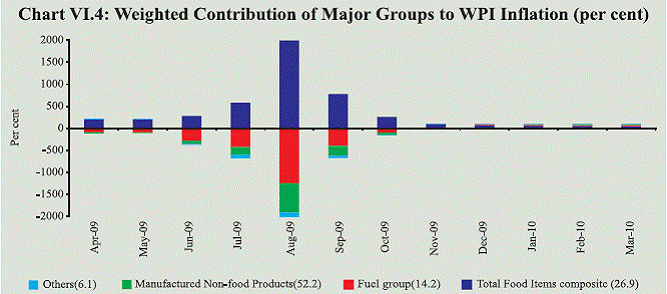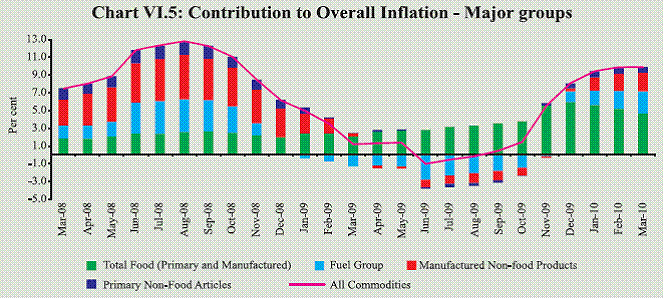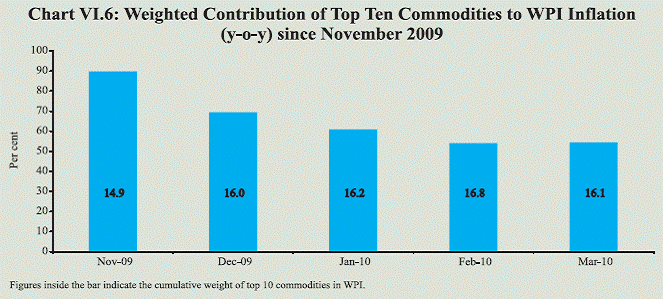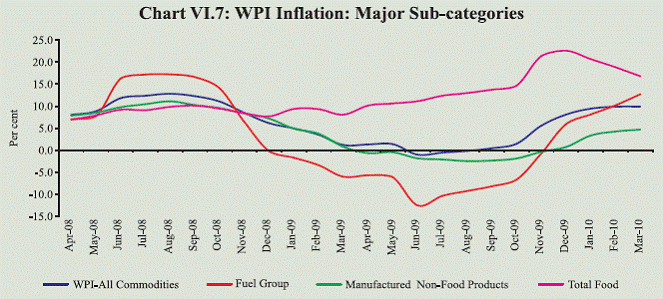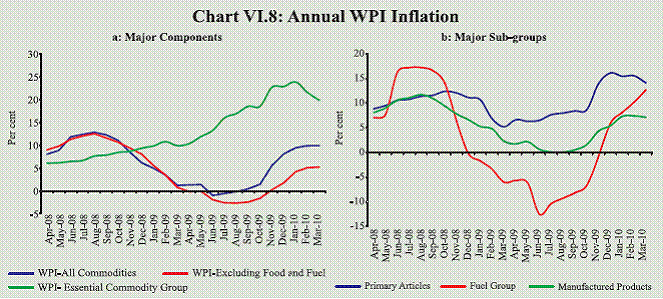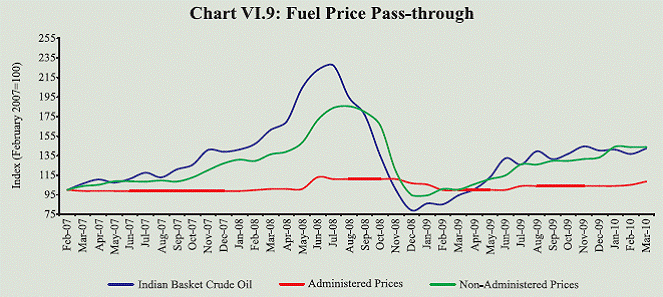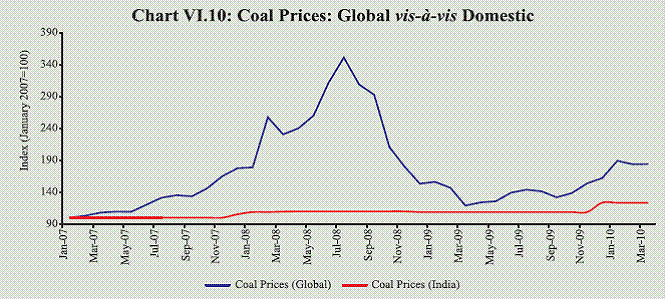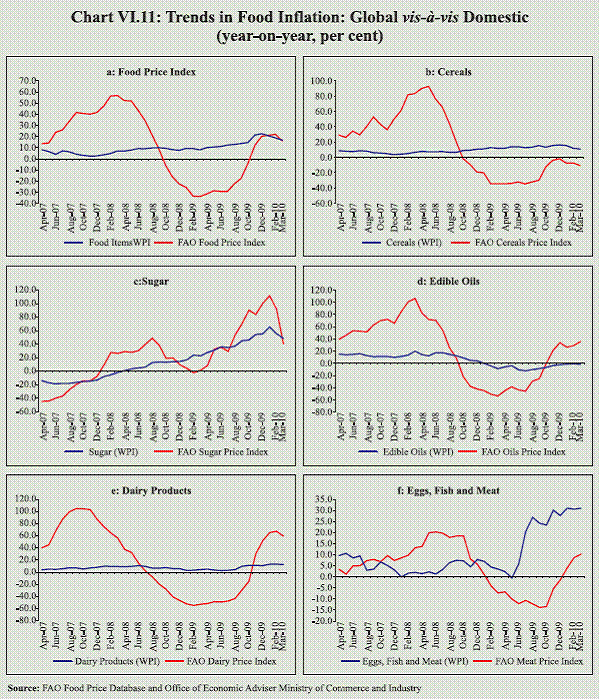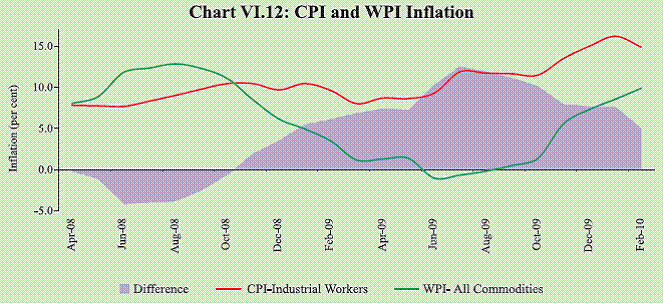VI. Price Situation - ఆర్బిఐ - Reserve Bank of India
VI. Price Situation
The Wholesale Price Index (WPI) inflation, after remaining significantly subdued during the first half of the year, increased at a faster pace in the second half and reached 9.9 per cent by February 2010, and remained almost unchanged at the same high level in March 2010. The Wholesale Price Index, though, exhibited secular increases throughout the year, indicating sustained momentum in inflation. Decline in agricultural production caused by deficient South-West monsoon as well as increases in international price of crude oil largely conditioned the inflation path. Indications of generalisation of inflation became increasingly evident starting from November 2009. Inflation in non-food manufactured products increased from (-)0.4 per cent in November 2009 to 4.7 per cent in March 2010. Alongside increasing generalisation of the inflation process, demand side pressures from certain quarters also became visible. Consumer price inflation moderated in February 2010 although it still remains high in double digits. With recovery in growth gaining momentum, the Reserve Banks’ policy emphasis has shifted to anchoring inflation expectations. VI.1 Inflationary conditions in India during 2009-10 were marked by two distinct phases. During the first half of 2009-10, the year-on-year WPI inflation remained significantly low (negative during June-August 2009) on account of the high base of sharp increases in prices recorded a year ago. This period, however, was characterised by a significant build-up of inflationary momentum, largely on account of the partial pass-through of increases in international prices. During the second half of the year, increasing food prices, on account of unfavourable agricultural supply conditions caused by the deficient South-West monsoon coupled with the waning of base effect led to sharp increase in inflation and the headline WPI inflation reached 9.9 per cent (y-o-y) in February 2010. Increase in international oil prices, and the resultant upward revision in POL prices also contributed to the inflation process during the course of the year. The recent increases in manufactured non-food products inflation signal how an inflation process triggered by supply side pressures could get generalised over time. The primary factor behind the rising headline inflation, i.e., food price inflation, however, has started to moderate since December 2009, largely reflecting seasonal pattern, though it still remains elevated. Moreover, inflation as per Consumer Price Indices (CPIs), which have a higher relative weight for food articles, though declined marginally in February 2010, still remain high. Global Inflation VI.2 Most advanced economies witnessed very low or negative headline inflation during the first half of 2009-10. This was mainly on account of the contraction in demand associated with the recession as well the impact of sharp decline in international commodity prices. The emerging economies also experienced significant decline in inflation, mostly due to decline in commodity prices and lower demand pressures on account of moderation in growth. During the second half of 2009- 10, inflation in major economies increased from sub zero/low levels, mainly reflecting the waning impact of the base (commodity prices had declined sharply during the second half of 2008-09 leading to decline in prices then in most countries). Some part of the recent increase in inflation across the globe could also be attributed to the rebound in commodity prices ahead of global recovery as well as gradual pick-up in demand as the economies work their way out of recession. VI.3 Except Japan, most economies registered positive, though subdued CPI inflation by November 2009 (Chart VI.1). Year-on-year consumer price inflation in OECD countries, which was negative during the period June-September 2009, increased to 1.9 per cent in February 2010. Core inflation (excluding food and energy) in OECD countries, after declining since September 2008, has remained stable at around 1.5 per cent since June 2009, indicating the limited pressure on inflation from the demand side. VI.4 During the first half of 2009-10, there were concerns over a possible deflationary spiral created by the negative inflation in the US, Japan and the Euro area. Those concerns abated with the recent increases in CPI inflation of major economies and stabilising core inflation. In the advanced economies, headline inflation is expected to pick up from 0.1 per cent in 2009 to 1.3 per cent in 2010, as rebound in energy prices could more than offset slowing labour costs. In emerging and developing economies, inflation is expected to increase from 5.2 per cent in 2009 to 6.2 per cent in 2010, as some of these economies may face growing upward pressures from limited economic slack and domestic liquidity effects of increased capital flows. In the emerging economies, inflationary pressures have remained subdued during 2009-10, albeit, with some firming up during the last quarter, except in India and Russia (Table VI.1). VI.5 Monetary policy stance of most central banks in the advanced economies during 2009-10 was conditioned by concerns over the recession and the subsequent fragile recovery, and policy rates accordingly were left unchanged at near zero levels. During the second half of the year inflationary pressures started to emerge in some economies, particularly those that witnessed faster than expected recovery and gradual closing of the output gap, which led to exit from easy monetary policy. The Reserve Bank of Australia and Bank of Israel have increased their policy rates by 125 and 100 basis points, respectively, since September 2009 on the back of signs of economic recovery and improvement in indicators of confidence (Table VI.1). Peoples Bank of China also raised the reserve requirement ratio by 50 basis points each in January and February 2010.
Global Commodity Prices VI.6 International commodity prices, which declined sharply during June- December 2008, gradually firmed up in 2009-10. Commodity price rebound ahead of global recovery has been driven by the expectations of recovery in growth and resultant tighter demand conditions in relation to supply (Table VI.2, Chart VI.2).
VI.7 Crude oil prices increased by about 70 per cent (year-on-year) in March 2010. According to the International Energy Agency (IEA) estimates, stronger global economic growth during 2010 may increase oil consumption by 1.7 million barrels per day. While this could suggest possible firming of crude oil prices, availability of ample surplus capacity may dampen any significant pressure on oil prices. VI.8 The increase in metal prices was led by the improvement in global economic prospects as well as supply cutbacks in response to the prolonged decline in price. International food prices have been increasing gradually (except in July 2009). The FAO Food Price Index, a measure of the monthly change in international prices of a food basket composed of cereals, oilseeds, dairy, meat and sugar increased significantly up to January 2010. The major driver of this increase was sugar, the production of which was affected in the two major sugar producers, i.e., India and Brazil. The FAO Food Price Index, however, declined by 6.8 per cent during January- March 2010 as sugar and cereals price indices declined by 29 per cent and 7 per cent, respectively. VI.9 The impact of increases in international commodity prices on domestic prices to an extent was modulated by the movements in exchange rate. As the exchange rate appreciated during the course of the year, the exchange rate pass-through effects helped in moderating the impact of higher international commodity prices on domestic inflation. Inflation Conditions in India VI.10 The global trends in commodity prices and domestic demand-supply balance pointed towards less pressure on prices during 2009-10 at the time of the Annual Policy Statement (APS) of the Reserve Bank for the year 2009-10 (April 2009) and accordingly the APS projected WPI inflation at around 4.0 per cent by end- March 2010. The APS reduced the policy rates further by 25 basis points to support the revival of economic growth as economic growth had declined well below its potential level on account of the impact of the crisis along with significant moderation in price pressures (Table VI.3). VI.11 The First Quarter Review (FQR) of Monetary Policy 2009-10 (July 2009) had highlighted that despite headline inflation turning negative, commensurate decline in inflationary expectations had not materialised. As the uncertain monsoon outlook increased the inflation risks, the FQR revised the end-March 2010 WPI inflation projection upward to 5.0 per cent. The Second Quarter Review (SQR) of Monetary Policy 2009-10 (October 2009) noted that the upside risk from deficient monsoon rainfall materialised and the baseline projection for WPI inflation at end- March 2010, therefore, was revised upwards to 6.5 per cent with an upside bias. The SQR noted that indications of consolidating recovery warranted a shift in policy stance from ‘managing the crisis’ to ‘managing the recovery’. The SQR also indicated the Reserve Bank’s commitment to a calibrated ‘exit’ from the expansionary monetary policy stance without hampering recovery process while anchoring inflation expectations and announced closure of some special liquidity support measures that had largely remained unutilised and restored the statutory liquidity ratio (SLR) of scheduled commercial banks to its pre-crisis level (25 per cent). It signalled the first phase of exit.
VI.12 The Third Quarter Review (TQR) of Monetary Policy 2009-10 (January 2010) raised the baseline projection for WPI inflation for March 2010 to 8.5 per cent on account of further strengthening of supply side pressures and emerging risks of such pressures spilling over on to a wider inflationary process. As part of the calibrated exit strategy, the CRR of scheduled banks was increased by 75 basis points from 5.0 per cent to 5.75 per cent of NDTL in two stages. Further, as WPI inflation increased and reached 9.9 per cent (y-o-y) in February 2010 amidst signs of generalisation of inflation, the Reserve Bank raised the repo and reverse repo rates under the LAF by 25 basis points each on March 19, 2010, balancing the needs of supporting recovery while anchoring inflation expectations. Wholesale Price Inflation VI.13 During the first half of 2009-10, the year-on-year WPI inflation remained moderate during April-May 2009 and subsequently turned negative during June- August 2009 on account of the strong base effect of the significant increase in administered prices of petroleum products in June 2008 (Chart VI.3a and b). The base effect of sharp increases in prices during the first half of 2008-09 waned during the second half as WPI had declined during the period September 2008-February 2009 (Chart VI.3a). The secular build up in price pressures, however, was visible throughout the year and WPI inflation increased significantly to 9.9 per cent by March 2010. The financial year build up of inflation exhibited secular uptrend during the year which was corroborated by the positive inflation momentum during all the months of 2009-10 (except June 2009) (Chart VI.3c and d).
VI.14 Though the WPI inflation remained moderate/negative during the first half of 2009-10, contrasting trends among the major sub-groups were visible during that period in terms of weighted contribution to the headline inflation. Since the rate of inflation in each month was different, the weighted contribution based analysis needs to be seen from the standpoint of making an assessment about the extent of variability resulting from different components of the WPI. Food inflation was significantly high during this period, which meant that food group (both primary food articles and manufactured food products) had a disproportionately larger contribution to inflation. On the other hand, fuel group exhibited large negative inflation, which pulled down the overall inflation low during the first half of the year (Chart VI.4 and Chart VI.5). In the second half of the year, inflation contribution came from all the major groups as positive contribution was visible from all the categories, indicating generalisation of inflation. VI.15 In terms of contribution to overall inflation by the major groups, the contribution of the fuel group, which was significantly negative since January 2009, showed a reversal of trend in recent months (Chart VI.5). The contribution of non-food manufactured products group, which declined during the receding phase of inflation and turned negative during April- November 2009, has also started to increase in recent months. Food articles and products, as a group continue to drive the overall WPI inflation, though its contribution has declined since December 2009.
VI.16 The supply constraints on account of the shortfall in agricultural production and increasing international crude prices were the major drivers of inflation in India uptill November 2009. The emergence of inflationary pressures, thus, was led by increases in prices of a few commodities and inflation remained concentrated in a few commodities. Since then, the inflation has become increasingly generalised as more number of commodities have started to exhibit significant pick-up in inflation. This is manifested in the declining share of top ten contributors to inflation since November 2009. The cumulative weight of the top ten contributors to inflation have also increased indicating that commodities with relatively higher weights have emerged as the drivers of inflation (Chart VI.6).
VI.17 When the inflation process tends to get generalised, the transmission from segmented pressures in certain items to the general inflation takes place with a lag, and during this period, containing inflation expectations becomes critical to enhance the effectiveness of monetary policy actions to reign in inflationary pressures. It can be expected that price pressure originating from inflation in fuel group may entail much greater risk to generalisation of inflation with more immediate impact as fuel enter as an intermediate input in most manufacturing products. Pressure from food price shocks on generalised inflation, on the other hand, may be gradual. This, to an extent, has been corroborated by the movements in manufactured non-food products inflation, which moved up significantly in recent months alongside increase in fuel inflation, while food inflation moderated in recent months (Chart VI.7). VI.18 The y-o-y WPI inflation excluding food and fuel consistently remained below the headline inflation during 2009-10. The trend of non-food non-fuel inflation, however, was mostly in sync with the headline inflation. Inflation in essential commodities group increased sharply during 2009-10, largely driven by food items’ price increases. Essential commodity inflation shows signs of moderation since January 2010 in line with the moderation in food prices (Chart VI.8a). VI.19 The increases in prices of food articles and food products have contributed 47 per cent of the build-up in WPI inflation during 2009-10. The upward revision of prices of petrol and diesel (effective July 2, 2009) and increase in prices of freely priced products under the fuel group in line with hardening of international crude oil prices further contributed to the increase in inflation during the year. Increases in administered prices of coal, reversal of excise and customs duty on petrol and diesel also partly contributed to the increase in inflation. Thus, the WPI inflation was above the Reserve Bank’s projection of 8.5 per cent by March 2010.
VI.20 Amongst the major groups, primary articles inflation, y-o-y, remained in single digit up to October 2009 and increased significantly thereafter, mainly on account of food prices, which registered high double-digit increase (Chart VI.8b). Some softening of inflation in primary articles is visible in recent months reflecting the seasonal moderation in prices of food articles and the impact of arrival of fresh crops in the market. VI.21 Year-on-year fuel group inflation, remained significantly negative during December 2008-November 2009 on account of the lower international crude oil prices compared to the very high levels in 2008. Fuel inflation turned positive in December 2009 reflecting the base effect of downward revision of administered prices in December 2008. The hikes in administered prices of petrol and diesel effective from July 2, 2009 and the reversal of customs and excise duty concessions given on petroleum products in the Union Budget for 2010-11, as part of the fiscal exit, led to increases in administered prices of petroleum products. Freely priced products under the minerals oil group followed the trends in international crude prices and gradually increased during the year (Chart VI.9). It is also to be noted that international oil prices remaining at current levels would imply a significant gap in the administered prices of petroleum products in relation to the price of Indian basket crude oil (converted to rupees at respective monthly average exchange rates), which would significantly increase the underrecoveries of oil marketing companies.
VI.22 Among the other major items in fuel group, coal prices were raised in January 2010 as global prices increased substantially (Chart VI.10). Increase in domestic coal prices, however, remain significantly lower than international prices. Electricity prices inflation remained moderate during the year. Recent increases in oil and coal prices may, over time, spillover to electricity prices.
VI.23 Manufactured products inflation, y-o-y, declined during the first half of 2009-10 mainly reflecting the significant negative inflation in metals. Manufactured products inflation, however, increased from 0.1 per cent in August 2009 to 7.1 per cent in March 2010 mainly driven by the manufactured food products, led by sugar (Table VI.4). The non-food manufacturing inflation, which was negative up to November 2009, has changed course since then and increased significantly to 4.7 per cent in March 2010. VI.24 Though the current inflation in food articles in India is quite significant, it needs to be noted that the international food prices have been much volatile in the recent past as compared to the domestic prices. Imports as an option to check price rise in India may not be fully effective as global inflation in food has already caught up with the high levels in India (Chart VI.11, Table VI.5).
Consumer Price Inflation VI.25 The divergence between WPI and CPI inflation increased during the first half of 2009-10 as WPI inflation declined and became negative while CPI inflation continued to increase. During the second half of the year, even though both CPI (up to January 2010) and WPI inflation increased, the increase in WPI inflation was much faster than CPI inflation. This led to some narrowing down of the gap between and WPI and CPI inflation in recent months (Table VI.6 and Chart VI.12). VI.26 Overall, while the inflation process continues to be dominated by supply factors, there is increasing evidence of generalisation as well as pick-up in demand in certain areas, which could be expected to continue with added momentum, going forward. Strong revival in import growth, major turnaround in corporate sales, gradual increase in capacity utilisation and recent trends in demand for credit from the private sector point to the emerging demand side risks to inflation. Though food prices have started to show seasonal moderation, the level still remains high. Fuel group inflation has accelerated significantly, reflecting higher prices of freely priced fuel products, upward revision in coal prices, and reversal in excise and customs duties that led to corresponding increases in POL product prices, besides the impact of low base. Pressure on the inflation process to get generalised has, therefore, been persistent. Non-food manufacturing products inflation rose from (-)0.4 in November 2009 to 4.7 per cent in March 2010 suggesting more generalisation of the inflation process. Given inflation persistence, high generalised inflation, if not contained, could aggravate inflation expectations and impede the ongoing recovery.
|
|||||||||||||||||||||||||||||||||||||||||||||||||||||||||||||||||||||||||||||||||||||||||||||||||||||||||||||||||||||||||||||||||||||||||||||||||||||||||||||||||||||||||||||||||||||||||||||||||||||||||||||||||||||||||||||||||||||||||||||||||||||||||||||||||||||||||||||||||||||||||||||||||||||||||||||||||||||||||||||||||||||||||||||||||||||||||||||||||||||||||||||||||||||||||||||||||||||||||||||||||||||||||||||||||||||||||||||||||||||||||||||||||||||||||||||||||||||||||||||||||||||||||||||||||||||||||||||||||||||||||||||||||||||||||||||||||||||||||||||||||||||||||||||||||||||||||||||||||||||||||||||||||||||||||||||||||||||||||||||||||||||||||||||||||||||||||||||||||||||||||||||||||||||||||||||||||||||||||||||||||||||||||||||||||||||||||||||||||||||||||||||||||||||||||||||||||||||||||||||||||||||||||||||||||||||||||||||||||||||||||||||||||||||||||||||||||||||||||||||||||||||||||||||||||||||||||||||||||||||||||||||||||||||||||||||||||||||||||||||||||||||||||||||||||||||||||||||||||||||||












